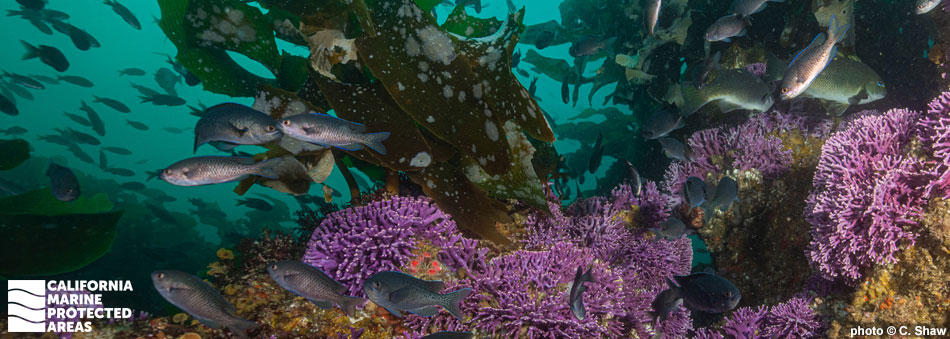
Overview
Farnsworth Onshore State Marine Conservation Area (SMCA) and Farnsworth Offshore SMCA are located on the windward side of Santa Catalina Island, a little more than 20 miles south-southwest of the Southern California mainland.
Farnsworth Onshore SMCA’s nearly 2¼ miles of rugged coastline is exposed to open ocean swells that hit the ‘backside’ of the island. This marine protected area (MPA) covers nearly three square miles, extending from the rocky shoreline to depths of around 300 feet, where it abuts Farnsworth Offshore SMCA. California halibut can be found hiding in the sand and surfgrass here, while kelp bass cruise through thick forests of giant kelp. Rocky reefs, boulders and archways provide ample opportunities to spearfish white seabass and pelagic finfish, which is permitted in the SMCA. The hidden coves and rocky intertidal areas provide critical habitat for both black abalone and white abalone.
The mostly sandy seafloor of Farnsworth Offshore SMCA is punctuated by a series of pinnacles and underwater mountains known as Farnsworth Bank. This SMCA covers nearly seven square miles at depths that vary from 135 feet to nearly 2,000 feet. The walls, valleys, and crevices of Farnsworth Bank offer divers an underwater paradise. A dive at Farnsworth Bank provides the opportunity to enjoy warm waters, amazing visibility, and the rare purple hydrocoral scattered across the bank. Rainbow scorpionfish cruise through the canyons while strawberry anemones carpet the walls, and mackerel, sardines, and yellowtail swim high above the seafloor.
Regulations
Farnsworth Onshore SMCA
It is unlawful to injure, damage, take, or possess any living, geological, or cultural marine resource, EXCEPT:
Recreational take of market squid by hand-held dip net; white seabass and pelagic finfish (northern anchovy, barracudas, billfishes, dorado (dolphinfish), Pacific herring, jack mackerel, Pacific mackerel, salmon, Pacific sardine, blue shark, salmon shark, shortfin mako shark, thresher shark, swordfish, tunas, Pacific bonito, and yellowtail) by spearfishing; and marlin, tuna and dorado by trolling is allowed.
Commercial take of coastal pelagic species (northern anchovy, Pacific sardine, Pacific mackerel, jack mackerel, and market squid) by round-haul net, brail gear, and light boat; and swordfish by harpoon is allowed (no commercial take of marlin is allowed). Not more than five percent by weight of any commercial coastal pelagic species catch landed or possessed shall be other incidentally taken species.
California Code of Regulations Title 14, Section 632(b)(129)(opens in new tab)
Farnsworth Offshore SMCA
It is unlawful to injure, damage, take, or possess any living, geological, or cultural marine resource, EXCEPT:
Recreational take of market squid by hand-held dip net; white seabass by spearfishing; pelagic finfish (northern anchovy, barracudas, billfishes, dorado (dolphinfish), Pacific herring, jack mackerel, Pacific mackerel, salmon, Pacific sardine, blue shark, salmon shark, shortfin mako shark, thresher shark, swordfish, tunas, Pacific bonito, and yellowtail) by hook-and-line or spearfishing, and marlin, tuna and dorado by trolling is allowed.
Commercial take of coastal pelagic species (northern anchovy, Pacific sardine, Pacific mackerel, jack mackerel, and market squid) by round-haul net, brail gear, and light boat; and swordfish by harpoon is allowed (no commercial take of marlin is allowed). Not more than five percent by weight of any commercial coastal pelagic species catch landed or possessed shall be other incidentally taken species.
California Code of Regulations Title 14, Section 632(b)(130)(opens in new tab)
Quick Facts
Farnsworth Onshore SMCA
MPA size: 2.59 square miles
Shoreline span: 2.2 miles
Depth range: 0 to 291 feet
Habitat composition*:
- Rock: 0.19 square miles
- Sand/mud: 2.48 square miles
Farnsworth Offshore SMCA
MPA size: 6.67 square miles
Depth range: 135 to 1,909 feet
Habitat composition*:
- Sand/mud: 6.11 square miles
- Rock: 0.56 square miles
*Habitat calculations are based on three-dimensional area and may exceed the total MPA area listed above.